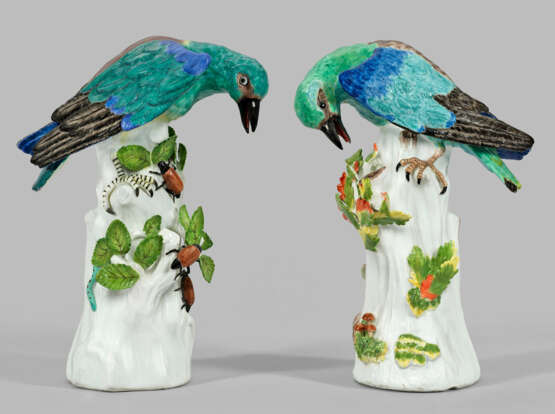ID 1407873
Lot 714 | Paar bedeutender Mandelkrähen von Meissen
Estimate value
€ 39 000 – 78 000
Auf einem hohen, mit Blüten und Blattranken, Käfern und Raupen belegtem Stamm eines Laubbaumes, zur Seite geneigte Mandelkrähe bei der Beobachtung seiner kleinen Beutetiere. Das Gegenstück auf belaubtem Stamm mit farblich konturierten Astlöchern und mit sprießenden Pilzen sitzend. Ihre Häupter einander zugeneigt. Naturalistisch gestaltetes, reliefiertes und sorgfältig gezeichnetes Federkleid in kräftig leuchtendem Türkisgrün und Blau, Braun bzw. Seegrün und wenig Gelb. Der schwarzbraune, geöffnete Schnabel mit sichtbarer Zunge. Entw. Johann Joachim Kaendler, 1735 bzw. Johann Joachim Kaendler und Johann Gottlieb Ehder, 1739 - 1740. Teilw. Pressziffern. Minim. best.; Rest.; H. 32,5 cm.
Das Modell der Mandelkrähe entwarf J. J. Kaendler ab 1735 im Auftrag von August dem Starken für das Japanische Palais. Um 1739 - 1740 erfolgte eine Überarbeitung durch Johann Gottlieb Ehder. Mit dem Japanischen Palais beabsichtigte August der Starke die Errichtung eines Porzellanschlosses, in dem Porzellanvögel und andere Tierplastiken zu Repräsentationszwecken ausgestellt werden. Der sächsische Hof im augusteischen Zeitalter war bekannt für seine bedeutenden Kunst- und Naturalienkammern. Das universale Interesse Augusts des Starken galt entsprechend der Mode der Zeit auch dem Exotischen. So veranlasste er 1731 eine Afrika-Expedition, woraufhin lebendige Tiere in den kurfürstlichen Menagerien ausgestellt wurden und Präparate zur Veranschaulichung dienten. Somit konnte Kaendler die Vogelwelt eingehend studieren. Die daraus resultierende Naturtreue in der Wiedergabe der Haltung und des Federkleides ist typisch für die Meissener Vogelplastik. Ausformungen derart früher Mandelkrähen finden sich heute in bedeutenden Kollektionen. Darunter eine Variante in der ehem. Slg. des Japanischen Palais, Dresden, heute Inv.-Nr. PE 16 oder im Metropolitan Museum of Art, New York, Inv.-Nr. 1974.356.237.
Vgl. Andres-Acevedo, Die autonomen figürlichen Plastiken Johann Joachim Kaendlers, Bd. 2, Nr. 97 u. Nr. 190.; Eikelmann, Kat. Slg. Schneider, Schloß Lustheim, S.374f.; Röbbig, Kabinettstücke, Nr. 30, S. 152 bzw. 145ff.
A pair of important colourful painted porcelain figures of an European roller. Minor chipped. Restored.
Meissen. Um 1740.
| Address of auction |
Kunstauktionshaus Schloss Ahlden GmbH Große Str. 1 29691 Ahlden(Aller) Germany | ||||||||||||||
|---|---|---|---|---|---|---|---|---|---|---|---|---|---|---|---|
| Preview | |||||||||||||||
| Phone | +49 5164 80100 | ||||||||||||||
| Buyer Premium | 25.0 | ||||||||||||||
| Conditions of purchase | Conditions of purchase | ||||||||||||||
| Business hours | Business hours
|



